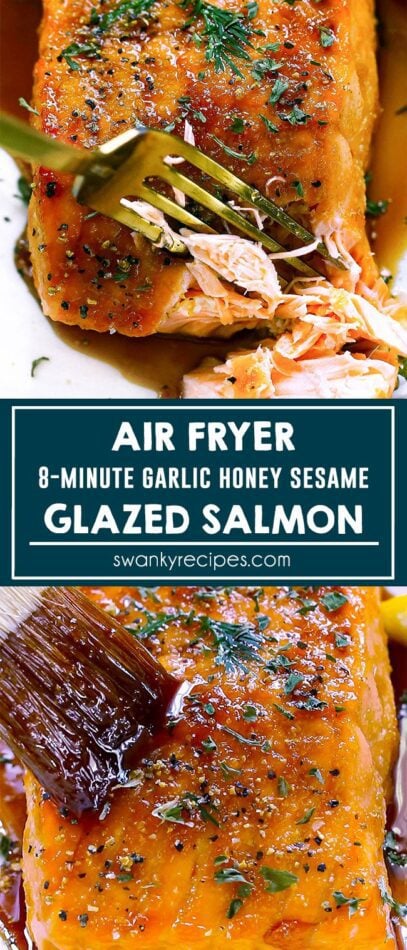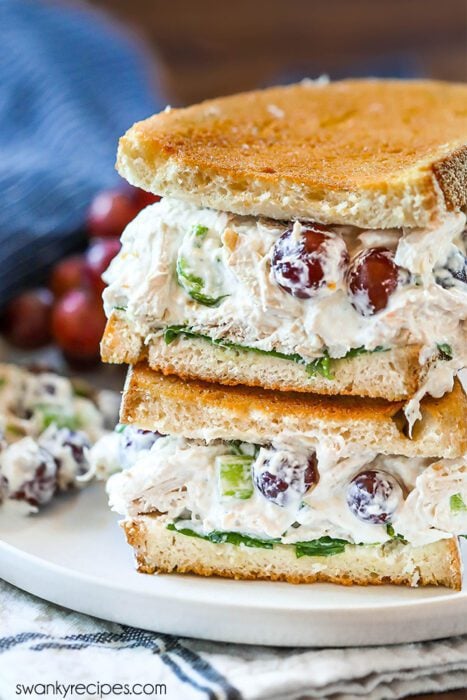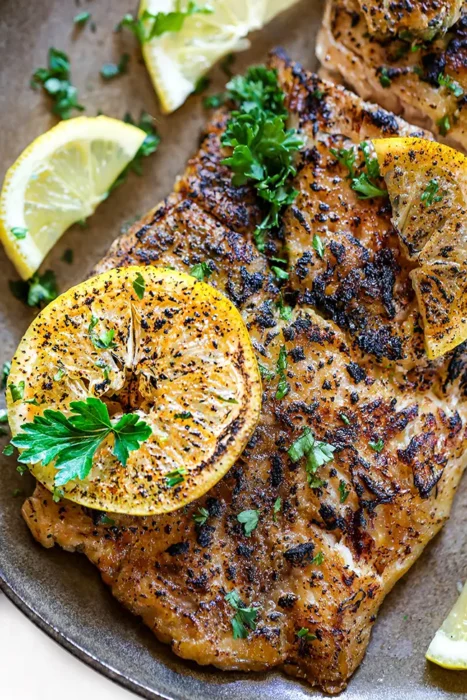
Of all the things to cook, I find that fish can be finicky, that’s why I love this Air Fryer Garlic Sesame Salmon recipe. Using the air fryer at home on the salmon will give it a tender flaky inside with seared edges. This fish recipe is literally a set it and forget it. Simply put the salmon in the air fryer and make the sauce. That’s it. Who needs to order takeout at a restaurant when you can make restaurant quality fish in the comfort of your own home in just minutes?
Whether it’s a busy night with the kids or you’re just getting home from work, this salmon along with a side of broccoli, green beans, or rice can be made in less than 15 minutes. It’s honestly one of the easiest fish recipes to prepare and it has a lot of health benefits, too.

How to Make Air Fryer Salmon
Preheat the Air Fryer
Set your air fryer to 400°F and allow it to preheat. This ensures that the salmon will cook evenly and develop a slightly crisp exterior while staying juicy inside.
Prepare the Salmon
Cut your salmon fillets into evenly sized portions to promote consistent cooking. Pat the pieces dry with a paper towel, then coat them generously with a light layer of olive oil. This will help the fish develop a nice sear in the air fryer.
Cook the Salmon
Arrange the oiled salmon fillets in the air fryer basket, ensuring they aren’t overcrowded. Air fry for about 8 minutes or until the salmon becomes opaque and flakes easily when pulled apart with a fork. The cooking time may vary slightly depending on the thickness of your fillets, so check for doneness.
Prepare the Honey Sesame Sauce
While the salmon cooks, whisk together 2 tablespoons of soy sauce, 1 tablespoon of honey, 1 tablespoon of rice vinegar, 1 teaspoon of sesame oil, and 1 clove of minced garlic in a small saucepan. This mixture will form a sweet and savory glaze with an Asian-inspired flavor profile.
Make the Slurry
In a separate small bowl, combine 1 teaspoon of cornstarch with 2 teaspoons of cold water, stirring until smooth. This slurry will help thicken the sauce to the perfect consistency.
Thicken the Sauce
Add the cornstarch slurry to the soy sauce mixture and bring it to a gentle boil. Once boiling, reduce the heat and let the sauce simmer until it thickens and reduces slightly, which should take about 3-4 minutes. Stir occasionally to prevent sticking.
Glaze the Salmon
Once the salmon is fully cooked, remove it from the air fryer and brush it generously with the honey sesame glaze. The sweet, sticky sauce will add a delicious coating to the flaky fish.
Serve
For an extra touch of brightness, serve the glazed salmon with fresh lemon slices on the side. The citrus will complement the flavors of the sauce and enhance the overall dish. Enjoy!
Salmon Tips
- Freshly squeezed lemon juice adds a lot of flavor and pairs wonderfully with salmon.
- Fresh salmon shouldn’t have any kind of strong fishy smell.
- Avoid fresh salmon that has any bruising or brown spots.
- If buying frozen salmon, buy it in an airtight freezer bag.
- Don’t buy fish that has any added color listed in the ingredients.

Air Fryer Salmon Ingredients
Salmon: Do a little research to see if there is a fish market nearby, you may be surprised. If not, buy your fish behind the counter at the grocery store on ice in the fish department. Get a piece of fish that has uniform thickness, looks moist, and is of a nice orange-red color. Pick salmon that has nice marbling and that the flesh springs back after it’s pressed lightly on. Can’t find good quality fresh salmon? Frozen salmon is fine, especially if it states its flash-frozen right after it’s caught.
Oil: Use any kind of oil. From vegetable oil, canola oil, olive oil, peanut oil, avocado oil, or grapeseed oil. Rubbing the fish with oil will prevent the fish from drying out as well as allow any seasoning to stick nicely to it.
Glaze: I’m using a classic Asian coating that I love. I make it with soy sauce, honey, lots of fresh garlic, a little rice vinegar, and sesame oil, and red pepper flakes for some spicy heat. The sauce should get boiled in a thickening agent like cornstarch. Simply make a slurry with water and add it to the saucepan. Bring it to a boil and allow the glazed sauce to thicken and reduce. Doing this step will make the coating thicker which will stick nicely to the air fryer baked fish.
Salmon: Wild-Caught VS. Farmed Raised
Salmon is one of the healthiest fish to eat. There are many different genera of salmon. This large fatty protein laden fish is loaded with omega-3 fatty acids along with antioxidants, and vitamin D. There is the farm raised or wild caught salmon as a well as salmon harvested in the wild from all over the world. Scottish salmon is chosen as the favorite time and time again due to the frigid waters that produce a higher fat content to give it a buttery texture with a more mild flavor.
What’s the difference between Norwegian, Atlantic, and Scottish salmon? It all comes down to different regions of farming salmon, flavor, texture, and taste. Norway is the largest producer of farmed Atlantic salmon. So what’s the difference between wild salmon and farmed salmon? Wild salmon are raised in there natural environment and eat natural organisms as a diet. Farmed salmon are given processed, high fat, high protein diets that make them larger. They have a completely different diet and environment than wild salmon. Overall, aim for wild salmon. Wild salmon has lower levels of containments and is considered safer overall. Atlantic salmon is typically farmed. Pacific salmon species are primarily wild-caught and healthier overall.

Preparing Salmon
When buying salmon at a fish market whole, as in one cut, it will need to be cut into fillets. The hard work has already been done. The scales of the fish have been removed. Next, you’ll want to cut them into fillets to cook or bake. Simply cut any ends off that dramatically reduce in size. Then, using a sharp knife, cut them into equal portions, removing any edges at the top of bottom that are smaller.
If you’d like, the deep gray skin can be removed, too. However, it is perfectly edible! To remove the skin, simply place the palm of your hand on top of the pink salmon. Make sure it’s facing up and the gray is at the bottom. Next, run a sharp knife along the bottom to remove the skin.
How do I defrost salmon? The quickest way to defrost salmon is to place it in it’s sealed bag in a bowl of cold water. The water should be replaced every 30 minutes until the salmon is no longer frozen. Another option to defrost salmon is to move it from the freezer to the refrigerator and simply let it thaw overnight. Of course, this process is a little longer, but if you’re prepared ahead and have time, this is easiest route to go.
Recipes to Pair with Salmon
- steamed rice
- fried rice
- roasted cauliflower
- oven-roasted broccoli
- green beans
- crunchy green salad
- roasted spaghetti squash noodles
- oven-roasted brussels sprouts
- couscous
- quinoa
- roasted butternut squash
- lo mein
- air fryer baked potatoes
- homemade hush puppies
Q: Should I buy the fish in fillets or can I buy it whole?
A: It doesn’t matter. I buy mine whole at a fish market nearby. Then, I simply cut them into equal portion fillets. I like this option because I know it’s coming from the same fish and not a different one.
Q: Does the skin get removed?
A: It depends how you like your salmon. If you’re new to eating salmon, it can stay on or off. The tough scales are typically removed and the remaining gray skin is totally edible. Salmon skin is fairly easy to remove when comparing it to many other types of fish. Use a sharp knife and cut along the bottom of the flesh to remove it
Q: Should I glaze the fish throughout air fryer baking it?
A: You can if you want. Sometimes, if the sauce is done early, I will baste the meat with some sauce toward the end of cooking. Then, brush more sauce on to finish before serving.
Q: Can I use frozen salmon?
A: Yes. Make sure the salmon is defrosted before cooking it in the air fryer. For instructions on how to defrost salmon, read the section “preparing salmon” in this recipe post.

Air Fryer Garlic Sesame Salmon
Equipment
- Air fryer
Ingredients
- 2 lb fresh salmon cut into 4-5 fillets
- 1 tbsp oil
- 2½ tbsp soy sauce
- ⅓ cup honey
- 1½ tsp rice vinegar
- ¼ tsp sesame oiil
- 3 cloves garlic minced
- 1½ tsp cornstarch
- 1½ tsp cold water
- ¼ tsp lemon pepper
- 1 tsp parsley optional
Instructions
- Cut salmon into 4-5 even size fillets. The skin can stay on otherwise to remove it, run a sharp knife along the skin; discard.
- Preheat air fryer to 400°F for 5 minutes.
- Oil salmon well on both sides with 1 tablespoon oil of choice.
- Once preheated, even spread salmon fillets in air fryer basket.
- Bake at 400°F for 8 minutes.
- Mix soy sauce, honey, rice vinegar, sesame oil, minced garlic, cornstarch and water in bowl.
- Heat in small saucepan over medium heat until reduced and thickened.
- Brush sauce on top of salmon.
- Sprinkle with lemon pepper and parsley.
Nutrition
Nutritional information is only an estimate and it’s accuracy is not guaranteed to be exact.
Save This Recipe To Your Recipe Box
Create an account on our website and save your favorite recipes. You’ll be able to access your recipe box on any device! You can keep track of your favorite recipes and generate a shopping list for recipes in your collections.






5 Responses
I grew up Catholic so fish on Friday was it. I hate fish period. So tried the glaze on chicken legs. It was great.
I love that you got creative and tried the glaze on chicken legs! I’m so glad it turned out great for you. Sometimes, a little twist on a recipe is all it takes to make it your own. Thanks for sharing!
This recipe was wonderful! I really enjoyed the sauce!
Easy to make. I used less than 1/3 c honey and it was still too sweet for me.
Dear Sherry,
Darn. Glad you tried our recipe and I appreciate the feedback. Everyone has different preferences when it comes to seasoning. Might I suggest if you are very sensitive to sweet flavoring, decrease all sweetening additives to 1/5th. Another option if you really like Salmon is to create a balsamic vinaigrette glaze. Balsamic is not sweet at all so maybe this would be more suited to your preferred palate.